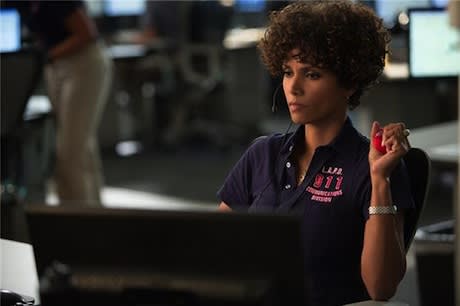Knowing very well that the premise unto itself is ludicrous — 911 operator Jordan Turner (Halle Berry) battles inner-demons to hunt down a serial kidnapper and killer of blonde teenage girls — director Brad Anderson handles The Call as an exercise in style and propulsion. He rushes through framing and exposition to focus on the intensity of any given situation, not letting up for nearly the entire runtime of the film, creating a ridiculous, but intensely kinetic little nail-biter.
During the opening, after a montage of 911 carnage sets the tone of an anarchic, dangerous and deteriorated culture out of control, Jordan takes a call from a teen girl experiencing a home invasion. Getting too wrapped up in the emotional intensity of the call — something Anderson handles extremely well, as does Berry, surprisingly — she hits redial when the call is disconnected, giving the location of the girl away and leading to her death.
Rather than focus on character arcs or psychology, Jordan is shown looking over the cityscape contemplatively for about 30 seconds and is suddenly a teacher rather than a 911 operator. This rather disturbing and shockingly aggressive little thriller isn't interested in characterizations — Jordan is literally defined by her astrological sign — when there's a high concept sequence on the horizon.
Inevitably, the shaken operator takes another call from young Casey Welson (Abigail Breslin), who has just been thrown in a trunk by a white man in a mall parking lot. And while the premise of a girl in a trunk and a woman in a call center talking for an hour sounds like it would be dull, The Call is nothing of the sort.
This entire sequence is assembled with quick edits, highly emotional responses and a host of clever tactics and hiccups to keep the audience on its toes. Beyond the emotional component of trying to calm a girl down certain of her death, asking for thoughts to be passed onto her mother after she's gone, the ingenuity that comes from their collective survival instincts are often surprising, as are the overall tactics to locate the moving vehicle. As such, it's very easy to ignore credulity and engage in the sensationalist, emotional experience of Anderson's nasty, exhilarating little thriller.
It's unfortunate that, like most films of this ilk, the final act, which attempts to resolve character dilemmas and explain the motivations of the killer, is laughable, but an odd nihilistic vein suggests intent. This is particularly clear in the final moments of the film when logic is thrown out the window entirely for camp id catharsis, reinforcing the subtext of marginalized people (literally every character in the movie is black, Latino, handicapped, gay/lesbian or female, save the killer) battling the white man.
There's even an American flag waving in the background at a key moment to add a sense of comic subversion to it all.
(Sony)During the opening, after a montage of 911 carnage sets the tone of an anarchic, dangerous and deteriorated culture out of control, Jordan takes a call from a teen girl experiencing a home invasion. Getting too wrapped up in the emotional intensity of the call — something Anderson handles extremely well, as does Berry, surprisingly — she hits redial when the call is disconnected, giving the location of the girl away and leading to her death.
Rather than focus on character arcs or psychology, Jordan is shown looking over the cityscape contemplatively for about 30 seconds and is suddenly a teacher rather than a 911 operator. This rather disturbing and shockingly aggressive little thriller isn't interested in characterizations — Jordan is literally defined by her astrological sign — when there's a high concept sequence on the horizon.
Inevitably, the shaken operator takes another call from young Casey Welson (Abigail Breslin), who has just been thrown in a trunk by a white man in a mall parking lot. And while the premise of a girl in a trunk and a woman in a call center talking for an hour sounds like it would be dull, The Call is nothing of the sort.
This entire sequence is assembled with quick edits, highly emotional responses and a host of clever tactics and hiccups to keep the audience on its toes. Beyond the emotional component of trying to calm a girl down certain of her death, asking for thoughts to be passed onto her mother after she's gone, the ingenuity that comes from their collective survival instincts are often surprising, as are the overall tactics to locate the moving vehicle. As such, it's very easy to ignore credulity and engage in the sensationalist, emotional experience of Anderson's nasty, exhilarating little thriller.
It's unfortunate that, like most films of this ilk, the final act, which attempts to resolve character dilemmas and explain the motivations of the killer, is laughable, but an odd nihilistic vein suggests intent. This is particularly clear in the final moments of the film when logic is thrown out the window entirely for camp id catharsis, reinforcing the subtext of marginalized people (literally every character in the movie is black, Latino, handicapped, gay/lesbian or female, save the killer) battling the white man.
There's even an American flag waving in the background at a key moment to add a sense of comic subversion to it all.




